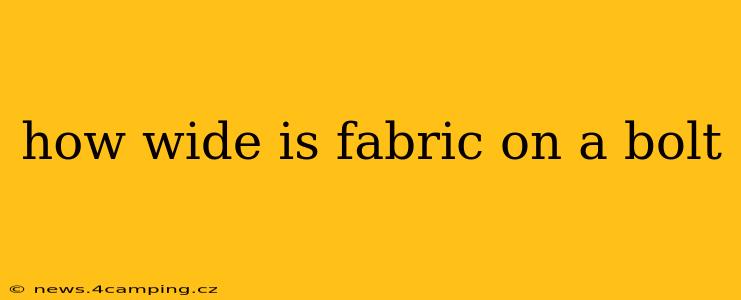Choosing the right fabric for your project often starts with understanding the width. Knowing how wide fabric comes on a bolt is crucial for planning your cuts, minimizing waste, and ensuring you have enough material. The answer, however, isn't a simple single number. Fabric bolt width varies greatly depending on the type of fabric and its manufacturer.
What are the common fabric bolt widths?
The most common bolt widths are 43-45 inches (109-114 cm) and 54-60 inches (137-152 cm). However, you might also find fabrics in other widths, including some that are narrower or wider.
-
43-45 inches (109-114 cm): This is a standard width for many woven fabrics like cotton, linen, and quilting cottons. It's a versatile width suitable for a broad range of projects.
-
54-60 inches (137-152 cm): This wider width is common for fabrics like home decor fabrics, upholstery fabrics, and some quilting fabrics. It's ideal for larger projects where minimizing seams is important.
-
Other widths: You might find narrower widths for specialty fabrics or wider widths for certain types of large-scale projects. Always check the product description or contact the seller to confirm the width.
Why does fabric width vary?
Several factors influence the width of fabric on a bolt:
-
Type of Fabric: The manufacturing process and the intended use of the fabric impact its width. For example, tightly woven fabrics might be narrower than loosely woven ones.
-
Manufacturer: Different manufacturers may use different weaving techniques and machinery, resulting in variations in fabric width.
-
Fabric Content: The type of fibers used (cotton, silk, polyester, etc.) can influence the final width of the fabric.
How can I find the width of a specific fabric?
To determine the exact width of a specific fabric, always check these resources:
-
Online Retailers: Most online fabric retailers provide detailed product descriptions, including fabric width. Look for specifications in the product listing.
-
Physical Fabric Stores: Ask a staff member for the width of the fabric you're interested in. They'll have access to accurate information.
-
Fabric Labels: The fabric label usually includes information about the fabric's composition, care instructions, and, sometimes, width.
What if the fabric width isn't what I expected?
It's always best to check the fabric width before making a purchase, particularly if you're working on a project with specific dimensions. If the fabric is narrower than anticipated, you'll need to adjust your cutting layout to accommodate the smaller width. This may result in more seams or require you to purchase more fabric than initially planned.
Does the width affect the price?
Generally, wider fabrics cost more per yard than narrower fabrics because they require more raw materials and manufacturing resources.
How does fabric width impact my sewing projects?
Understanding fabric width is crucial for several aspects of sewing:
-
Pattern Layout: You'll need to adjust your pattern pieces based on the fabric width to efficiently use your fabric and minimize waste.
-
Seam Allowance: Always account for seam allowance when calculating the amount of fabric needed, considering the final dimensions of your project.
-
Project Planning: Accurate knowledge of fabric width helps you determine the yardage required for your projects, avoiding costly mistakes.
In conclusion, while common fabric bolt widths exist, there’s significant variation. Always check the specified width before purchasing to ensure it suits your project. Careful planning, coupled with accurate width information, ensures your sewing project’s success.
